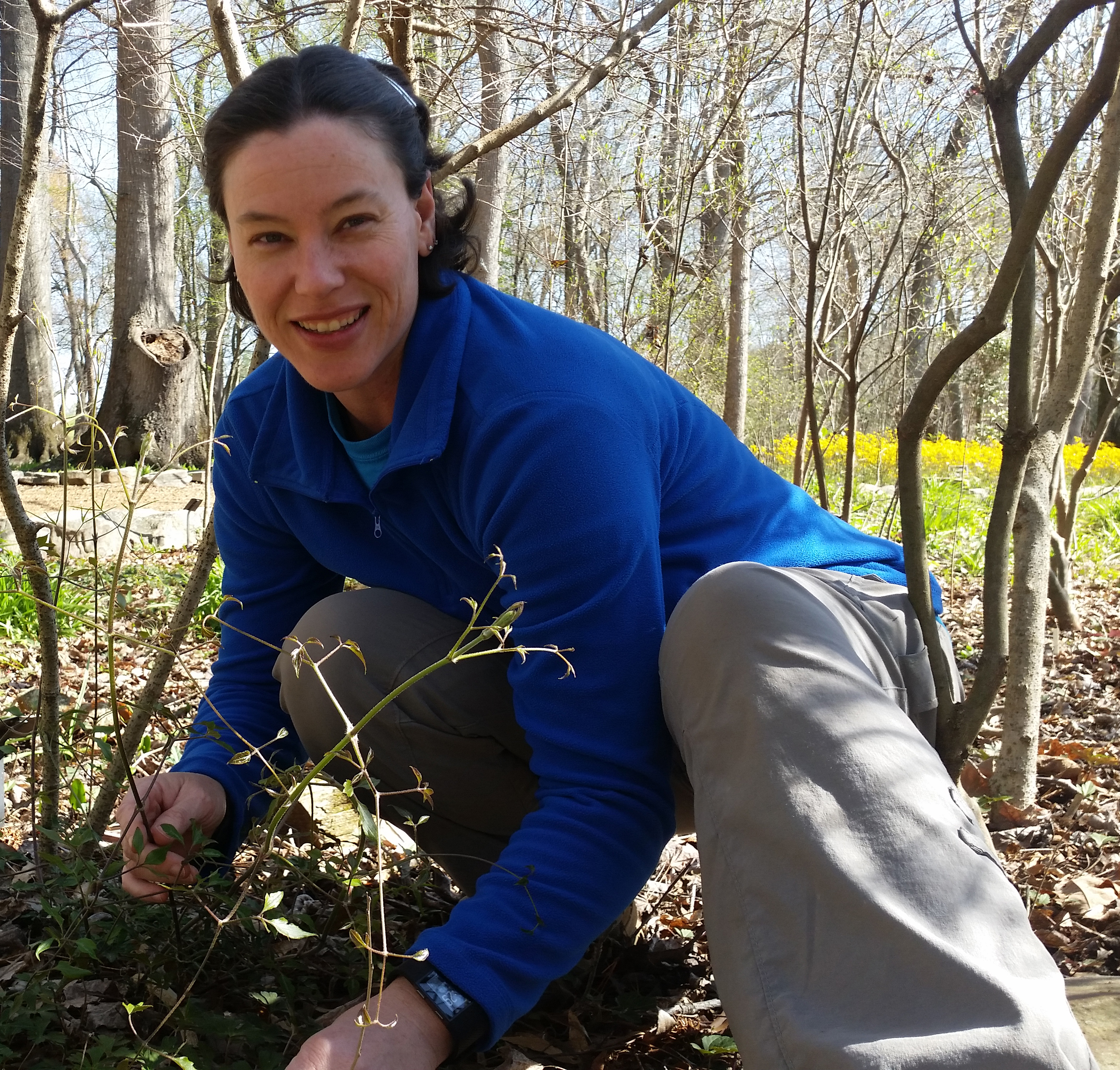Viburnum acerifolium, Mapleleaf Viburnum (Located on the Mathews Nature Trail)

Viburnum acerifolium, also known as Mapleleaf Viburnum, is a densely branched deciduous shrub, 4-12 feet tall and 3-4 feet wide. This member of the Adoxaceae (Moschatel) family is native to eastern North America and features fragrant tiny white flowers in showy flat-topped 3-inch cymes in May that attract many kinds of pollinators and butterflies. Mapleleaf Viburnum is a larval host for Celastrina ladon (the Spring Azure butterfly); it will grow under Black Walnut and has nice pink-purple fall color. More shade tolerant than many of the other species in its genus, it also thrives in a wide range of soils with good drought tolerance once it is established. It is useful for naturalizing in open woodland areas and adding interest in shrub borders with well-drained soil in full sun to part shade. The fruit provides excellent food for birds as they ripen in late summer.
Asclepias quadrifolia, Fourleaf Milkweed (Located on the Mathews Nature Trail)
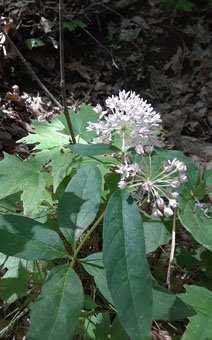
Asclepias quadrifolia, commonly known as four-leaf milkweed, is an erect herbaceous perennial that grows to 12-30 inches tall and 9-18 inches wide. This member of the Apocynaceae (Dogbane) family is native to dry rocky woods in eastern North America. Plants in the Asclepias genus are known for their milky sap, complex floral structures, and the value of the leaves and nectar for butterflies and moths. Four-leaf milkweed grows best in full sun to part shade and dry to medium soil moisture and produces showy, fragrant, pale purplish-pink flowers May – July. The flowers are followed by interesting smooth, narrow seed pods which are valued in dried flower arrangements. Fourleaf Milkweed will naturalize in woodland gardens and is deer and drought tolerant and highly beneficial for pollinators. Danaus plexippus (Monarch butterflies) need milkweed plants in order to survive – the adult consumes the nectar and lays eggs on the leaves, and the emerging caterpillars consume the leaves, which serves as both a food source and protection since a diet of milkweed makes them poisonous to would-be predators. This is one of 23 species of milkweed known to grow in Alabama.
Spigelia marilandica, Indian pink (Located on the Mathews Nature Trail)
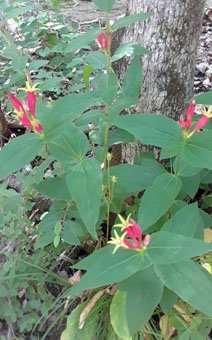
Spigelia marilandica, also known as Indian Pink, is a clump-forming herbaceous perennial that has upright stalks that can grow 18 inches tall and wide. This member of the Loganiaceae family is endemic to moist woods and streambanks in southeastern North America. The upward facing trumpet-shaped red flowers are yellow inside, flaring at the top to give it the appearance of a five-pointed yellow star in May and June. Indian Pinks grow well in part shade to full shade in average to dry soils. It is a deer-resistant “star” performer in shade gardens or wildflower gardens and attracts hummingbirds. Some good companion plants are Phlox divaricate (Woodland Phlox), Chrysogonum virginianum (Green and Gold), Iris cristata (Dwarf Crested Iris), Tiarella cordifolia (Foamflower) and Heuchera americana (Coral bells).
Ruellia caroliniensis, Wild Petunia (Located on the Mathews Nature Trail)

Ruellia caroliniensis, commonly known as Wild Petunia, is an upright non-branching perennial that grows to 2-3 feet tall. This long-blooming native perennial produces showy lavender – purple trumpet-shaped flowers in the leaf axils. Usually, only a few of the light purple flowers are open on any given day, so plant in masses for best effect. This member of the Acanthaceae family is found naturally occurring in dry-mesic forested areas in the southeast U.S. Most members of Acanthaceae are tropical herbs, shrubs, twining vines, or epiphytes. Wild Petunia tolerates disturbance and drought, naturalizes well, blooms May – September, and attracts many different types of pollinators. In particular, Wild Petunia is a host plant for the larva of the Junonia coenia (Common Buckeye butterfly) and Anartia jatrophae (White Peacock butterfly). R. caroliniensis is one of seven members of this genus occurring in eastern North America. It grows best in full sun to part shade in dry soils (suitable for xeriscaping).
Hydrangea macrophylla ‘Lynn’, Let’s Dance® Starlight Bigleaf Hydrangea (Located on the Bush
Azalea Trail)
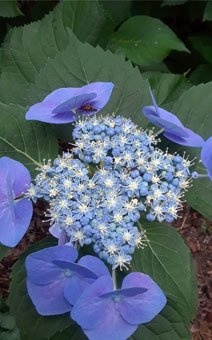
Hydrangea macrophylla, also known as Bigleaf Hydrangea, is a deciduous shrub with a rounded habit that typically grows 3-6 feet tall and wide. This member of the Hydrangeaceae family is native to Japan grows best in well-drained soils in part shade. Many cultivars, or cultivated varieties, exist.H. macrophylla ‘Lynn’, commonly sold under the trade name of Let’s Dance® Starlight, is a compact cultivar that flowers on both old and new wood (called re-blooming). It typically grows to 2-3 feet tall and wide that features lacecap-like blue or pink clusters of flowers (depending on the soil pH -blue in highly acidic soils and pink in slightly acidic to alkaline soils) May-August. Aluminum sulfate may be added to the soil to make the flowers bluer, or lime to make the flowers pinker starting in late autumn or early spring.
Clematis crispa, Swamp Leather Flower (Located on the Bush Azalea Trail)
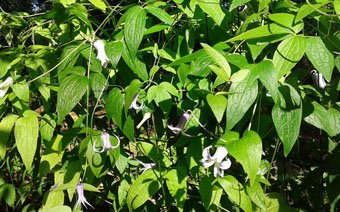
Clematis crispa,
commonly called Swamp Leather Flower, is a deciduous herbaceous twining vine that
grows to 6-10 feet tall and 3-6 feet wide. This member of the Ranunculaceae (Buttercup) family is
native to the southeastern United States in floodplain forests, marshes, and
swamps. Showy, pale violet bell-shaped flowers bloom at the tendril tips May to
July. The slightly fragrant flowers produce attractive seed heads after
pollination. Swamp Leather Flower needs consistently moist soils in full sun to
part shade, and can be trained to climb a structure or allowed to sprawl as a
ground cover. C. crispa tolerates
deer browse, clay soils, and Black Walnut juglandins, making it a great plant
for troublesome areas.

